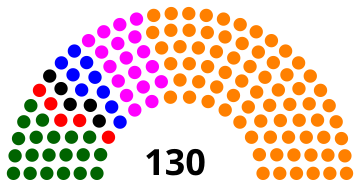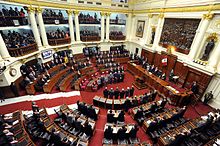Congress of the Republic of Peru
| logo | Congress building |
|---|---|

|

|
| Basic data | |
| Seat: | Palacio Legislativo in Lima , Peru |
| Legislative period : | 5 years |
| First session: | 1822 |
| MPs: | 130 |
| Current legislative period | |
| Last choice: | Elections on April 10, 2016 |
| Website | |
| www.congreso.gob.pe | |
The Peruvian Congress ( Spanish Congreso de la República del Perú ) is the parliament of Peru . It is a unicameral parliament with 130 members, each elected for five years. The elections to Congress take place at the same time as the presidential elections and are based on proportional representation (divided into regions) .
history
After Peru gained independence in 1821 , José de San Martín had a constituent congress elected, which initially had two chambers during the tenure of its president, Francisco Xavier de Luna Pizarro Pacheco , who later became Archbishop of Lima .
Differences between the libertador (liberator) and the new parliament led to the withdrawal of San Martín, who left the country. The same happened to his colleagues José de La Mar and José de la Riva Agüero . 1824 came Simon Bolivar to Peru, and Congress gave him the power in the country. Bolivar issued a new constitution and established a three-chamber parliament. However, this constellation only had a short lifespan.
Another new constitution set up a bicameral parliament, which existed until 1992 . During this time, the congress was an important element in the changeable political events in Peru, but often came under pressure from those in power.
In 1968 General Juan Velasco Alvarado took power in a coup. He dissolved the Congress, which only met again in 1978 as part of a constituent assembly and passed the new 1979 constitution.
The current constitution was passed in 1993 after the congress elected in 1990 ( camara de diputados ) was closed by a coup by the elected President Alberto Fujimori . Since then, the congress consists of only one chamber with 120 members.
In 2009 , a constitutional amendment resolved to increase the number of MPs to 130 from the next congressional election in 2011 in order to better represent the growing population.
At the end of September 2019, a dispute between Martín Vizcarra and Congress over the appointment of judges at the Peruvian Constitutional Court escalated . The opposition-controlled Congress wanted to select two new constitutional judges without the usual public bid process. On September 30, 2019, Vizcarra then dissolved the Congress and announced new elections. In return, Congress decided to suspend Vizcarra and appointed Vice President Mercedes Aráoz as interim president, but she resigned from her post only a day later. The next parliamentary and presidential elections were originally planned for April 2021.
function
The Peruvian Constitution gives Congress the following tasks:
- Legislation: Congress discusses and passes the country's laws (see also Art. 90, 104–108).
- Control of the executive branch: Congress has the duty and power to control the actions of government and public administration (see also Art. 56–57, 77–82, 85–87, 96–102, 104, 113–116, 118, 130-133, 135-137, 178).
- Control of the judiciary (see also Art. 161, 201, 203, 206).
- Representation of the population: The Congressmen of the Republic represent not only their constituencies but the entire nation (see also Art. 39 and 93).
composition
The parliamentary elections on April 9, 2006 resulted in the following composition:
- Unión por el Perú ( Ollanta Humala ): 45 MPs
- Partido Aprista Peruano ( Alan García ): 36 MPs
- Unidad Nacional ( Lourdes Flores ): 17 MPs
- Alianza por el Futuro ( Martha Chávez ): 13 MPs
- Frente de Centro ( Valentín Paniagua ): 5 MPs
- Restauración Nacional ( Humberto Lay ): 2 MPs
- Other parties: 2 MPs
The parliamentary elections on April 10, 2011 resulted in the following composition:
- Gana Perú : 44 MPs
- Fuerza 2011 : 35 MPs
- Perú Posible : 22 MPs
- Alianza por el Gran Cambio : 17 MPs
- Alianza Solidaridad Nacional : 11 MPs
- Partido Aprista Peruano : 4 MPs
The last parliamentary elections on April 10, 2016 resulted in the following composition:

|
||||||||
|---|---|---|---|---|---|---|---|---|
| Parties | Seats | be right | percent | |||||
| Fuerza Popular | 73 | 4,431,077 | 36.34 % | |||||
| Peruanos Por el Kambio | 18th | 2,007,710 | 16.47% | |||||
| Front Amplio | 20th | 1,700,052 | 13.94% | |||||
| Alianza para el Progreso | 9 | 1,125,682 | 9.23% | |||||
| APRA | 5 | 1,013,735 | 8.31% | |||||
| Acción Popular (Peru) | 5 | 877.734 | 7.20% | |||||
| Democracia Directa | 0 | 528,301 | 4.33% | |||||
| Perú Posible | 0 | 286,980 | 2.35% | |||||
| Frente Esperanza | 0 | 139.634 | 1.15% | |||||
| Partido Político Order | 0 | 68.474 | 0.56% | |||||
| Progresando Peru | 0 | 14.663 | 0.12% | |||||
| All in all | 130 | 12,194,042 | 100.00% | |||||
Parliament seat
Statue of Bolívar in front of the Palacio Legislativo.
The chambers of the first congress met in different places: The Chamber of Deputies in the former main building of the Universidad Nacional Mayor de San Marcos and the Senatorial Chamber in the former Inquisition building . The entire parliament later moved into this building. The places of assembly changed several times in the history of the country; During the saltpeter war against Chile they met in a secret place.
In the 20th century the congress finally moved to its current location, the Palacio Legislativo in the center of Lima opposite the Plaza Bolívar . The "Palacio del Congreso" was built in 1908 according to plans by the French architect Emile Robert and was modified in the 1930s by the architects Claudio Sahut and Ricardo de Jaxa Malachowski in the Belle Époque style.
Web links
- Official Website (Spanish)
- Results of the congressional elections on the El Mundo website
Individual evidence
- ↑ a b PERU (Congreso de la República), full text . In: IPU PARLINE database . Retrieved June 7, 2016.
- ↑ Peruvian parliament has 10 more members . Infoamazonas. Retrieved March 24, 2011.
- ↑ Johan Ramírez: Political Chaos in Peru . Deutsche Welle , October 2, 2019.
- ↑ The power struggle in Peru escalates . In: tagesschau.de, October 1, 2019 (accessed October 1, 2019).
- ^ Text of the Peruvian Constitution on the website of the Congress of the Republic
- ^ Result of the 2006 congress elections (PDF; 436 kB) Archived from the original on March 14, 2013. Retrieved on March 23, 2011.
- ↑ ELECTION FOR CONGRESO DE LA REPÚBLICA 2016 . Retrieved June 1, 2016.
- ^ Peru - A Wiki on National Parliament Buildings Worldwide . Retrieved June 7, 2016.
Coordinates: 12 ° 2 ′ 53 ″ S , 77 ° 1 ′ 30 ″ W



